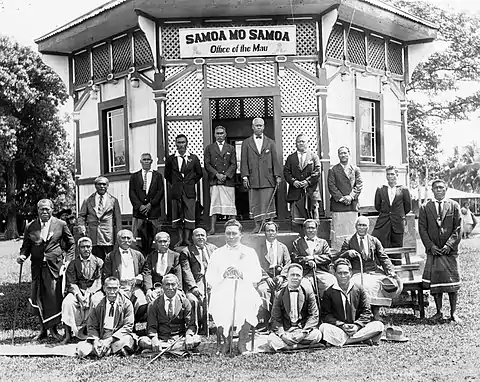Tupua Tamasese Lealofi III
Tupua Tamasese Lealofi-o-ā'ana III (4 May 1901 – 29 December 1929) was a paramount chief of Samoa, who became the leader of the country's pro-independence Mau movement during the early 1900s until his death in 1929.[1] Inspired by his Christian beliefs, traditional customs and culture of Samoa, Lealofi III became one of the first leaders of the 20th century to employ nonviolent resistance against colonial rule which laid the foundations for Samoa's successful campaign and independence in 1962.


He was fatally shot by New Zealand police during a peaceful Mau procession in Apia on 28 December 1929, in what became known as Black Saturday.[2]

His tomb, constructed of black stones in a tier is situated in Lepea village beside the main road and 5 minutes from Apia.
His younger brother, Meaole, succeeded him as holder of Tupua Tamasese title and became Tupua Tamasese Meaole. He was instrumental in the final stages of securing Samoa's independence, chairing the national Constitutional Committee before assuming office in 1962 as co-Head of State of the newly independent State of Western Samoa.
Tupua Tamasese Lealofi III's eldest son was Tupua Tamasese Lealofi IV (1922–1983), who served two terms as Samoa's prime minister and later, as Deputy Head of State.[3]
See also
- History of Samoa
- Tupua Tamasese
- Fa'amatai, chiefly system of Samoa.
References
- Guardians of the West by Albert Wendt.Retrieved 21 February 2009
- "New Zealand in Samoa". New Zealand History Online. Retrieved 21 February 2009.
- Fortune, Kate (2000). "Tupua Tamasese Lealofi IV". In Brij V. Lal (ed.). The Pacific Islands : an encyclopedia ([Repr.]. ed.). Honolulu: University of Hawai'i Press. pp. 286–287. ISBN 082482265X.